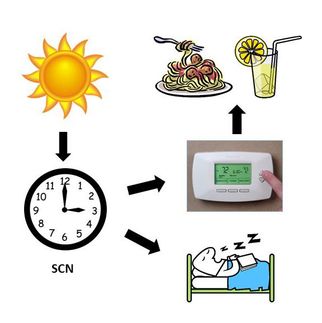Chronobiology: Sleep and synaptic rhythms
Chronobiologists at Ludwig-Maximilians-Universität (LMU) in Munich, Germany, show in two articles in the journal Science how critical the sleep-wake cycle is for protein and phosphorylation dynamics in synapses to ultimately regulate its activity.
The internal clock controls virtually all physiological processes in the human body predicting daily recurring environmental changes such as day and night. How the circadian rhythm and sleep influences molecular mechanisms at the cellular level in the brain is not yet fully understood. Professor Maria Robles, head of a research group at the Institute of Medical Psychology at LMU Munich, shows in two recent articles published in the journal Science how sleep and wake cycles, rather than the circadian clock, drive cycles of protein abundance as well as phosphorylation in synaptic proteins to orchestrate dynamics of synaptic activity in the brain. "Our work shows that sleep-wake cycles play a central role in the temporal regulation of many aspects of synaptic functions," says Maria Robles.
The LMU chronobiologist and her research group use mass spectrometry-based quantitative proteomics to profile daily dynamics of protein and phosphorylation in in vivo isolated synapses from mouse forebrain. For the studies in Science, the team investigated how synaptic proteome and phosphoproteome are dynamically shaped across the day and how it is affected by sleep deprivation.
In one study the group shows that in a normal day, one fourth of the 8,000 phosphorylations in many critical synaptic proteins oscillates with two main peaks: one when the mice wake up and a second one just before they fall asleep. "This suggests that synaptic phosphorylation plays a key role in the regulation of synaptic function in particular at the sleep-wake-sleep transitions," says Maria Robles. This characteristic phosphorylation pattern seems to reflect buildup and dissipation of sleep and wake pressure since sleep deprivation almost completely abolished synaptic phosphorylation rhythms. "Our study shows that key synaptic processes, from house-keeping to plasticity are temporally regulated trough phosphorylation, in response to both sleep and wake pressure, ” says Maria Robles.
In the second study published in the same issue of Science the same group, in collaboration with a group from the University of Zürich (Steve Brown), has showed that synaptic protein abundance is also rhythmically shaped by sleep-wake cycles. In particular, they demonstrated that synaptic activity triggers the cycling production of proteins from messenger molecules that rhythmically accumulate at the synapses across the day. While protein production completely depends on wake-sleep cycles, messenger molecules travel and accumulate in the synapses predominantly in response to circadian mechanisms.
Original publication
Franziska Brüning, Sara B Noya, Tanja Bange, Stella Koutsouli, Jan D Rudolph, Shiva Tyagarajan, Jürgen Cox, Matthias Mann Steven A Brown3 and Maria S Robles; "Sleep-wake cycles drive daily dynamics of synaptic phosphorylation"; Science 2019.
Sara B. Noya, David Colameo, Franziska Brüning, Andrea Spinnler, Dennis Mircsof, Lennart Opitz, Matthias Mann, Shiva Tyagarajan, Maria S. Robles, and Steven A. Brown; "The Forebrain Synaptic Transcriptome is Organized by Clocks, but its Proteome is Organized by Sleep"; Science 2019
Most read news
Original publication
Franziska Brüning, Sara B Noya, Tanja Bange, Stella Koutsouli, Jan D Rudolph, Shiva Tyagarajan, Jürgen Cox, Matthias Mann Steven A Brown3 and Maria S Robles; "Sleep-wake cycles drive daily dynamics of synaptic phosphorylation"; Science 2019.
Sara B. Noya, David Colameo, Franziska Brüning, Andrea Spinnler, Dennis Mircsof, Lennart Opitz, Matthias Mann, Shiva Tyagarajan, Maria S. Robles, and Steven A. Brown; "The Forebrain Synaptic Transcriptome is Organized by Clocks, but its Proteome is Organized by Sleep"; Science 2019
Topics
Organizations
Other news from the department science

Get the life science industry in your inbox
By submitting this form you agree that LUMITOS AG will send you the newsletter(s) selected above by email. Your data will not be passed on to third parties. Your data will be stored and processed in accordance with our data protection regulations. LUMITOS may contact you by email for the purpose of advertising or market and opinion surveys. You can revoke your consent at any time without giving reasons to LUMITOS AG, Ernst-Augustin-Str. 2, 12489 Berlin, Germany or by e-mail at revoke@lumitos.com with effect for the future. In addition, each email contains a link to unsubscribe from the corresponding newsletter.





















































